A Decade of Sanitary Fellings Followed by Climate Extremes in Croatian Managed Forests
Abstract
1. Introduction
2. Materials and Methods
3. Study Area
4. Results
4.1. Ice Storm in 2014
4.2. Bark Beetle Outbreak in 2017
4.3. The Aftermath of Bark Beetle Outbreaks in Two Uneven-Aged Silver Fir Stands
4.4. Summer Storms in 2023
5. Discussion
- (1)
- The influence of ice weight on the bending, tilting, and spreading of trees was more pronounced in beech (Fagus sylvatica L.) and other broadleaved trees, as opposed to conifers.
- (2)
- Broken and split trunks were represented in beech at an amount of 22.6% (other broadleaved species at 20.4%), which, in addition to fallen trees, represented an additional loss. In contrast, the loss of silver fir and European spruce trees due to this form of damage was only about 1.5%.
- (3)
- The largest proportion of trees with broken tree tops was represented in European spruce (39.7%), then other broadleaved species (39.2%) and beech (35.2%), with the least for silver fir (28.3%).
- (4)
- The timber volume of fallen and broken trees and trees with large canopy damage (over 80%) amounted to about 103,000 m3 or 63% of the prescribed 10-year allowable cut for 2012–2021. The damaged timber volume of beech, which participated in the mixture ratio, was 28.4% (almost doubled the amount of the prescribed 10-year allowable cut).
- (5)
- The damage made to forest roads was at a length of 753 km. The estimation of the recovery costs of lysis amounted to EUR 445,956.
- (6)
- The damage to wild game is observed through direct mortality of large and small game and through long-term changes in population dynamics caused by significant habitat changes. The mortality in game caused by storms is quite difficult to determine due to fallen timber, impassability, etc. Increased anthropogenic disturbance due to recovery operations leads to increased stress on the area’s wild animals. As a result of increased calamities, the direct measure is a ban on hunting until the population recovers to a satisfactory state, and the indirect measures are supplementary nutrition, reduced harassment, etc.
6. Conclusions
Author Contributions
Funding
Data Availability Statement
Acknowledgments
Conflicts of Interest
References
- Dobor, L.; Hlásny, T.; Rammer, W.; Zimová, S.; Barka, I.; Seidl, R. Is salvage logging effectively dampening bark beetle outbreaks and preserving forest carbon stocks? J. Appl. Ecol. 2020, 57, 67–76. [Google Scholar] [CrossRef]
- Wohlgemuth, T.; Schwitter, R.; Bebi, P.; Sutter, F.; Brang, P. Post-windthrow management in protection forests of the Swiss Alps. Eur. J. For. Res. 2017, 136, 1029–1040. [Google Scholar] [CrossRef]
- Leverkus, A.B.; Rey Benayas, J.M.; Castro, J.; Boucher, D.; Brewer, S.; Collins, B.M.; Gustafsson, L. Salvage logging effects on regulating and supporting ecosystem services A systematic map. Can. J. For. Res. 2018, 48, 983–1000. [Google Scholar] [CrossRef]
- Lindroth, A.; Lagergren, F.; Grelle, A.; Klemedtsson, L.; Langvall, O.; Weslien, P.; Tuulik, J. Storms can cause Europe-wide reduction in forest carbon sink. Glob. Change Biol. 2009, 15, 346–355. [Google Scholar] [CrossRef]
- Seidl, R.; Schelhaas, M.J.; Rammer, W.; Verkerk, P.J. Increasing forest disturbances in Europe and their impact on carbon storage. Nat. Clim. Change 2014, 4, 806. [Google Scholar] [CrossRef]
- Nilsson, C.; Stjernquist, I.; Bärring, L.; Schlyter, P.; Jönsson, A.M.; Samuelsson, H. Recorded storm damage in Swedish forests 1901–2000. For. Ecol. Manag. 2004, 199, 165–173. [Google Scholar] [CrossRef]
- Seidl, R.; Schelhaas, M.J.; Lexer, M.J. Unraveling the drivers of intensifying forest disturbance regimes in Europe. Glob. Change Biol. 2011, 17, 2842–2852. [Google Scholar] [CrossRef]
- Food and Agriculture Organization of the United Nations (FAO) ANNUAL REPORT 2019. Available online: https://openknowledge.fao.org/items/ba08937f-4a41-4ff5-a4e7-e495e5f5f599 (accessed on 20 March 2025).
- CIFOR ANNUAL REPORT 2019. Forests in a Time of Crises. Available online: https://www.cifor.org/annualreport2019/ (accessed on 20 March 2025).
- Lindner, M.; Maroschek, M.; Netherer, S.; Kremer, A.; Barbati, A.; Garcia-Gonzalo, J.; Seidl, R.; Delzon, S.; Corona, P.; Kolström, M.; et al. Climate change impacts, adaptive capacity, and vulnerability of European forest ecosystems. For. Ecol. Manag. 2010, 259, 698–709. [Google Scholar]
- Myneni, R.B.; Keeling, C.D.; Tucker, C.J.; Asrar, G.; Nemani, R.R. Increased plant growth in the nothern high latitudes from 1981 to 1991. Nature 1997, 386, 698–702. [Google Scholar]
- Linares, J.C.; Camarero, J.J.; Carreira, J.A. Competition modulates the adaptation capacity of forests to climatic stress: Insights from recent growth decline and death in relict stands of the Mediterranean fir Abies pinsapo. J. Ecol. 2010, 98, 592–603. [Google Scholar]
- Markham, A. Potential Impacts of Climate Change on Ecosystems: A Review of Implications for Policy Makers and Conservation Biologists. Clim. Res. 1996, 6, 179–191. [Google Scholar] [CrossRef]
- Marini, L.; Lindelöw, Å.; Jönsson, A.M.; Wulff, S.S.; Schroeder, M.L. Population dynamics of the spruce bark beetle: A long-term study. Oikos 2013, 122, 1768–1776. [Google Scholar] [CrossRef]
- Økland, B.; Berryman, A.A. Resource dynamic plays a key role in regional fluctuations of the spruce bark beetles Ips typographus. Agric. For. Entomol. 2004, 6, 141–146. [Google Scholar] [CrossRef]
- Wermelinger, B. Ecology and management of the spruce bark beetle Ips typographus—A review of recent research. For. Ecol. Manag. 2004, 202, 67–82. [Google Scholar] [CrossRef]
- Grégoire, J.C.; Evans, H.F. Damage and control of Bawbilt organisms—An overview. In Bark and Wood Boring Insects in Living Trees in Europe; Lieutier, F., Day, K.R., Battisti, A., Grégoire, J.-C., Evans, H.F., Eds.; A Synthesis; Kluwer Academic Publishers: Dordrecht, The Netherlands, 2004; pp. 19–37. [Google Scholar] [CrossRef]
- Schelhaas, M.J.; Nabuurs, G.J.; Schuck, A. Natural disturbances in the European forests in the 19th and 20th centuries. Glob. Change Biol. 2003, 9, 1620–1633. [Google Scholar] [CrossRef]
- Økland, B.; Bjørnstad, O.N. A resource depletion model of forest insect outbreaks. Ecology 2006, 87, 283–290. [Google Scholar] [CrossRef]
- Krokene, P. Conifer defense and resistance to bark beetles. In Biology and Ecology of Native and Invasive Species; Vega, F.E., Hofstetter, R.W., Eds.; Elsevier Academic Press: San Diego, CA, USA, 2015; pp. 177–207. [Google Scholar] [CrossRef]
- Kremer, A. Evolutionary Responses of European Oaks to Climate Change. Irish Forestry. 2010. Available online: https://journal.societyofirishforesters.ie/index.php/forestry/article/view/10039 (accessed on 18 March 2025).
- Bűrger, R.; Krall, C. Quantitative-genetic models and changing environments. In Evolutionary Conservation Biology; Ferriere, R., Dieckmann, U., Couvet, D., Eds.; Cambridge University Press: Cambridge, UK, 2004; pp. 171–187. [Google Scholar]
- Kärvemo, S.; Rogell, B.; Schroeder, M. Dynamics of spruce bark beetle infestation spots: Importance of local population size and landscape characteristics after a storm disturbance. For. Ecol. Manag. 2014, 334, 232–240. [Google Scholar] [CrossRef]
- Bauhus, J.; Puettmann, K.J.; Kühne, C. Close-to-nature forest management in Europe: Does it support complexity and adaptability of forest ecosystems? In Managing Forests as Complex Adaptive Systems; Routledge: London, UK, 2013; pp. 187–213. [Google Scholar] [CrossRef]
- Gardiner, B.; Schuck, A.; Schelhaas, M.-J.; Orazio, C.; Blennow, K.; Nicoll, B. (Eds.) Living with Storm Damage to Forests; European Forest Institute: Joensuu, Finland, 2013; Available online: https://www.researchgate.net/profile/Andreas-Schuck-2/publication/263924439_Storm_damage_in_Europe_-_A_overview/links/5602c3b108ae849b3c0ecf05/Storm-damage-in-Europe-A-overview.pdf (accessed on 19 March 2025).
- Gustafsson, L.; Bauhus, J.; Asbeck, T.; Augustynczik, A.L.D.; Basile, M.; Frey, J.; Gutzat, F.; Hanewinkel, M.; Helbach, J.; Jonker, M.; et al. Retention as an integrated biodiversity conservation approach for continuous-cover forestry in Europe. Ambio 2020, 49, 85–97. [Google Scholar] [CrossRef]
- Isaacs, R.E.; Stueve, K.M.; Lafon, C.W.; Taylor, A.H. Ice storms generate spatially heterogeneous damage patterns at the watershed scale in forested landscapes. Ecosphere 2014, 5, 1–14. [Google Scholar] [CrossRef]
- Ge, J.; Xiong, G.; Wang, Z.; Zhang, M.; Zhao, C.; Shen, G.; Xu, W.; Xie, Z. Altered dynamics of broad-leaved tree species in a Chinese subtropical montane mixed forest: The role of an anomalous extreme 2008 ice storm episode. Ecol. Evol. 2015, 5, 1484–1493. [Google Scholar] [CrossRef]
- Nagel, T.A.; Firm, D.; Rozenbergar, D.; Kobal, M. Patterns and drivers of ice storm damage in temperate forests of Central Europe. Eur. J. For. Res. 2016, 135, 519–530. [Google Scholar] [CrossRef]
- Marziliano, P.A.; Lombardi, F.; Cataldo, M.F.; Mercuri, M.; Papandrea, S.F.; Manti, L.M.; Bagnato, S.; Alì, G.; Fusaro, P.; Pantano, P.S.; et al. Forest Fires: Silvicultural Prevention and Mathematical Models for Predicting Fire Propagation in Southern Italy. Fire 2024, 7, 278. [Google Scholar] [CrossRef]
- Pausas, J.G.; Keeley, J.E. Wildfires and global change. Front. Ecol. Environ. 2021, 19, 387–395. [Google Scholar] [CrossRef]
- Keeley, J.E.; Bond, W.J.; Bradstock, R.A.; Pausas, J.G.; Rundel, P.W. Fire in Mediterranean Ecosystems: Ecology, Evolution and Management; Cambridge University Press: Cambridge, UK, 2011; 522p. [Google Scholar] [CrossRef]
- Moreira, F.; Ascoli, D.; Safford, H.; Adams, M.A.; Moreno, J.M.; Pereira, J.M.C.; Catry, F.X.; Armesto, J.; Bond, W.; González, M.E.; et al. Wildfire management in Mediterraneantype regions: Paradigm change needed. Environ. Res. Lett. 2020, 15, 011001. [Google Scholar] [CrossRef]
- Barčić, D.; Dubravac, T.; Ančić, M.; Rosavec, R. Analysis of the Fire Season of 2020 in the Mediterranean Bioclimatic Zone of Croatian Adriatic. South-East Eur. For. SEEFOR 2022, 13, 115–125. [Google Scholar] [CrossRef]
- Camarero, J.J.; Valeriano, C.; Ortega, M. Transient Post-Fire Growth Recovery of Two Mediterranean Broadleaf Tree Species. Fire 2024, 7, 400. [Google Scholar] [CrossRef]
- Turco, M.; Rosa-Cánovas, J.J.; Bedia, J.; Jerez, S.; Montávez, J.P.; Llasat, M.C.; Provenzale, A. Exacerbated fires in Mediterranean Europe due to anthropogenic warming projected with non-stationary climate-fire models. Nat. Commun. 2018, 9, 3821. [Google Scholar] [CrossRef]
- Stephens, S.L.; Agee, J.K.; Fulé, P.Z.; North, M.P.; Romme, W.H.; Swetnam, T.W.; Turner, M.G. Managing forests and fire in changing climates. Science 2013, 342, 41–42. [Google Scholar] [CrossRef]
- Thom, D.; Rammer, W.; Dirnböck, T.; Müller, J.; Kobler, J.; Katzensteiner, K.; Seidl, R. The impacts of climate change and disturbance on spatio-temporal trajectories of biodiversity in a temperate forest landscape. J. Appl. Ecol. 2017, 54, 28–38. [Google Scholar] [CrossRef]
- Thom, D.; Rammer, W.; Seidl, R. Disturbances catalyse the adaptation of forest ecosystems to changing climate conditions. Glob. Chang. Biol. 2017, 23, 269–282. [Google Scholar] [CrossRef]
- Thom, D.; Seidl, R. Natural disturbance impacts on ecosystem services and biodiversity in temperate and boreal forests. Biol. Rev. Camb. Philos. Soc. 2016, 91, 760–781. [Google Scholar] [CrossRef]
- Kulakowski, D.; Seidl, R.; Holeksa, J.; Kuuluvainen, T.; Nagel, T.A.; Panayotov, M.; Svoboda, M.; Thorn, S.; Vacchiano, G.; Whitlock, C.; et al. A walk on the wild side: Disturbance dynamics and the conservation and management of European mountain forest ecosystems. For. Ecol. Manag. 2017, 388, 120–131. [Google Scholar] [CrossRef] [PubMed]
- Lamers, P.; Junginger, M.; Dymond, C.C.; Faaij, A. Damaged forests provide an opportunity to mitigate climate change. GCB Bioenergy 2014, 6, 44–60. [Google Scholar] [CrossRef]
- Parisi, F.; Lombardi, F.; Sciarretta, A.; Tognetti, R.; Campanaro, A.; Marchetti, M.; Trematerra, P. Spatial patterns of saproxylic beetles in a relic silver fir forest (Central Italy), relationships with forest structure and biodiversity indicators. For. Ecol. Manag. 2016, 381, 217–234. [Google Scholar] [CrossRef]
- Gutzat, F.; Dormann, C. Decaying trees improve nesting opportunities for cavity-nesting birds in temperate and boreal forests: A meta-analysis and implications for retention forestry. Ecol. Evol. 2018, 8, 8616–8626. [Google Scholar] [CrossRef]
- Thorn, S.; Seibold, S.; Leverkus, A.B.; Michler, T.; Müller, J.; Noss, R.F.; Stork, N.; Vogel, S.; Lindenmayer, D.B. The living dead: Acknowledging life after tree death to stop forest degradation. Front. Ecol. Environ. 2020, 18, 505–512. [Google Scholar] [CrossRef]
- Porro, Z.; Odicino, M.; Bogliani, G.; Chiatante, G. Intensive forestry and biodiversity: Use of poplar plantations by woodpeckers in a lowland area of Northern Italy. For. Ecol. Manag. 2021, 497, 119490. [Google Scholar] [CrossRef]
- De Steven, D.; Kline, J.; Matthiae, P.E. Long-term changes in a Wisconsin Fagus-Acer forest in relation to glaze storm disturbance. J. Veg. Sci. 1991, 2, 201–208. [Google Scholar] [CrossRef]
- Hooper, M.C.; Arii, K.; Lechowicz, M.J. Impact of a major ice storm on an old-growth hardwood forest. Can. J. Bot. 2001, 79, 70–75. [Google Scholar] [CrossRef][Green Version]
- Rhoads, A.G.; Hamburg, S.P.; Fahey, T.J.; Siccama, T.G.; Hane, E.N.; Battles, J.; Cogbill, C.; Randall, J.; Wilson, G. Effects of an intense ice storm on the structure of a northern hardwood forest. Can. J. For. Res. 2002, 32, 1763–1775. [Google Scholar] [CrossRef]
- Lafon, C.W. Ice-storm disturbance and long-term forest dynamics in the Adirondack Mountains. J. Veg. Sci. 2004, 15, 267–276. Available online: https://www.jstor.org/stable/3236761 (accessed on 20 December 2024). [CrossRef]
- Brommit, A.G.; Charbonneau, N.; Contreras, T.A.; Fahrig, L. Crown loss and subsequent branch sprouting of forest trees in response to a major ice storm. J. Torrey Bot. Soc. 2004, 131, 169–176. [Google Scholar] [CrossRef]
- Arii, K.; Lechowicz, M.J. Changes in understory light regime in a beech–maple forest after a severe ice storm. Can. J. For. Res. 2007, 37, 1770–1776. [Google Scholar] [CrossRef]
- Patacca, M.; Lindner, M.; Lucas-Borja, M.E.; Cordonnier, T.; Fidej, G.; Gardiner, B.; Hauf, Y.; Jasinevičius, G.; Labonne, S.; Linkevičius, E.; et al. Significant increase in natural disturbance impacts on European forests since 1950. Glob. Change Biol. 2023, 29, 1359–1376. [Google Scholar] [CrossRef]
- Pons, P.; Rost, J.; Tobella, C.; Puig-Girones, R.; Bas, J.M.; Franch, M.; Mauri, E. Towards better practices of salvage logging for reducing the ecosystem impacts in Mediterranean burned forests. iForest 2020, 13, 360–368. [Google Scholar] [CrossRef]
- Oszlányi, J. Forest health and environmental pollution in Slovakia. Environ. Pollut. 1997, 98, 389–392. [Google Scholar] [CrossRef]
- Morissette, J.L.; Cobb, T.P.; Brigham, R.M.; James, P.C. The response of boreal forest songbird communities to fire and post-fire harvesting. Can. J. For. Res. 2002, 12, 2169–2183. [Google Scholar] [CrossRef]
- Lindenmayer, D.B.; Burton, P.J.; Franklin, J.F. Salvage Logging and Its Ecological Consequences; Island Press: Washington, DC, USA, 2008; p. 227. [Google Scholar]
- IPCC. Summary for policymakers. In Climate Change 2013: The Physical Science Basis; Stocker, T., Qin, D., Plattner, G.K., Eds.; Contribution of Working Group I to the Fifth Assessment Report of the Intergovernmental panel on Climate Change; Cambridge University Press Book Section SPM: Cambridge, UK, 2013; pp. 1–30. [Google Scholar]
- Fink, A.H.; Brücher, T.; Ermert, V.; Krüger, A.; Pinto, J.G. The European storm Kyrill in January 2007: Synoptic evolution, meteorological impacts and some considerations with respect to climate change. Nat. Hazards Earth Syst. Sci. 2009, 9, 405–423. [Google Scholar] [CrossRef]
- Mölter, T.; Schindler, D.; Albrecht, A.T.; Kohnle, U. Review on the projections of future storminess over the North Atlantic European region. Atmosphere 2016, 7, 60. [Google Scholar] [CrossRef]
- Örlander, G.; Nilsson, U. Effect of Reforestation Methods on Pine Weevil (Hylobius abietis) Damage and Seed-ling Survival. Scand. J. For. Res. 1999, 14, 341–354. [Google Scholar] [CrossRef]
- Gibbs, W.J.; Maher, J.V. Rainfall Deciles as Drought Indicators; Bureau of Meteorology Bulletin: Melbourne, Australia, 1967.
- Raziei, T. Revisiting the Rainfall Anomaly Index to serve as a Simplified Standardized Precipitation Index. J. Hydrol. 2021, 602, 126761. [Google Scholar] [CrossRef]
- Tadić, L.; Dadić, T.; Bosak, M. Usporedba različitih metoda za ocjenu suše na području kontinentalne suše. Građevinar 2015, 67, 11–22. [Google Scholar] [CrossRef]
- Ugarković, D.; Jezidžić, D.; Tonković, Z. Description of Some Methods for Meteorological Drought Analysis. Nova Meh. Šumarstva 2024, 45, 79–87. (In Croatian) [Google Scholar] [CrossRef]
- TIBCO Software Inc. Statistica (Data Analysis Software System), Ver. 13. 2018. Available online: http://tibco.com (accessed on 20 December 2024).
- Čavlović, J. Prva Nacionalna Inventura šuma Republike Hrvatske; Ministarstvo Regionalnog Razvoja, Šumarstva i Vodnoga Gospodarstva i Šumarski Fakultet Sveučilišta u Zagrebu: Zagreb, Croatia, 2010; p. 300. [Google Scholar]
- Čavlović, J.; Božić, M. National Forest Inventory in Croatia–Terrain Data Aquisition Methods; University of Zagreb Faculty of Forestry: Zagreb, Croatia, 2008; p. 146. (In Croatian) [Google Scholar]
- Teslak, K.; Beljan, K.; Vedriš, M.; Žunić, M.; Komarčević, M.; Čavlović, J. Ice storm influence on forests status and structure in Gorski kotar region. In Zbornik Radova sa Znanstvenog Skupa “Gospodarenje Šumama u Uvjetima Klimatskih Promjena i Prirodnih nepogoda”; Anić, I., Ed.; Hrvatska Akademija Znanosti i Umjetnosti: Zagreb, Croatia, 2020; pp. 77–101. [Google Scholar]
- Ficko, A.; Beljan, K.; Vedriš, M.; Čavlović, J.; Teslak, K. Neighborhood effects on tree growth in a Fagus sylvatica—Abies alba forest following an ice storm. For. Ecosyst. 2024, 11, 100250. [Google Scholar] [CrossRef]
- Available online: https://www.hrsume.hr (accessed on 20 May 2024).
- Available online: https://adria-balkan.fsc.org/en/fsc-in-the-adria-balkan-region/cro (accessed on 5 June 2024).
- Available online: https://biodiversity.europa.eu/countries/croatia (accessed on 20 May 2024).
- Available online: https://www.eea.europa.eu/themes/biodiversity/natura-2000/the-natura-2000-protected-areas-network/ (accessed on 12 July 2024).
- Nagel, T.A.; Mikac, S.; Dolinar, M.; Klopcic, M.; Keren, S.; Svoboda, M.; Diaci, J.; Boncina, A.; Paulic, V. The natural disturbance regime in forests of the Dinaric Mountains: A synthesis of evidence. For. Ecol. Manag. 2017, 388, 29–42. [Google Scholar] [CrossRef]
- Sinjur, I.; Vertacnik, G.; Likar, L.; Hladnik, V.; Miklavcic, I.; Gustincic, M. Ice storm in Slovenia in January and February 2014—Spatial and temporal variability in weather across the dinaric landscapes in Slovenia. Gozdarski Vestn. 2014, 72, 299–309. (In Slovenian) [Google Scholar]
- Vertacnik, G.; Dolinar, M.; Sinjur, I.; Gustincic, M. Meteorological conditions during the ice storm causing glaze ice at the end of January and the beginning of February 2014. Ujma 2015, 29, 149–173. Available online: https://plus.cobiss.net/cobiss/si/sl/bib/4286118 (accessed on 10 October 2024). (In Slovenian).
- Anić, I. Zaključci sa Znanstvenog Skupa Gospodarenje Šumama u Uvjetima Klimatskih Promjena I Prirodnih Nepogoda. Available online: https://info.hazu.hr/upload/file/2020/Zakljucci_ocjena-stanja-i-preporuke_PDF-(1).pdf (accessed on 11 September 2024). (In Croatian).
- Available online: https://meteo.hr/objave_najave_natjecaji.php?section=onn¶m=objave&el=priopcenja&daj=pr21072023 (accessed on 12 July 2024).
- Gamfeldt, L.; Snall, T.; Bagchi, R.; Jonsson, M.; Gustafsson, L.; Kjellander, P.; Riuz-Jaen, M.C.; Froberg, M.; Stendahl, J.; Philipson, C.D.; et al. Higher levels of multiple ecosystem services are found in forests with more tree species. Nat. Commun. 2013, 4, 59. [Google Scholar] [CrossRef]
- Seidl, R.; Spies, T.A.; Peterson, D.L.; Stephens, S.L.; Hicke, J.A. Searching for resilience: Addressing the impacts of changing disturbance regimes on forest ecosystem services. J. Appl. Ecol. 2016, 53, 120–129. [Google Scholar] [CrossRef]
- Csilléry, K.; Kunstler, G.; Courbaud, B.; Allard, D.; Lassègues, P.; Haslinger, K.; Gardiner, B. Coupled effects of wind-storms and drought on tree mortality across 115 forest stands from the Western Alps and the Jura mountains. Glob. Change Biol. 2017, 23, 5092–5107. [Google Scholar]
- Anderegg, W.R.L.; Kane, J.M.; Anderegg, L.D.L. Consequences of widespread tree mortality triggered by drought and temperature stress. Nat. Clim. Change 2013, 3, 30–36. [Google Scholar] [CrossRef]
- Blennow, K.; Persson, J.; Wallin, A.; Vareman, N.; Persson, E. Understanding risk in forest ecosystem services: Implications for effective risk management, communication and planning. Forestry 2014, 87, 219–228. [Google Scholar] [CrossRef]
- Xi, W.; Peet, R.K.; Decoster, J.K.; Urban, D.L. Tree damage risk factors associated with large, infrequent wind disturbances of Carolina forests. Forestry 2008, 81, 317–334. [Google Scholar] [CrossRef]
- Peterson, C.J. Consistent influence of tree diameter and species on damage in nine eastern North America tornado blowdowns. Ecol. Manag. 2007, 250, 96–108. [Google Scholar] [CrossRef]
- Šimunić, I. Regulation and Protection of Water; Hrvatska Sveučilišna Naklada: Zagreb, Croatia, 2016; p. 165. [Google Scholar]
- Tikvić, I.; Ugarković, D. General and Landscape Ecology of Temperate Forest Ecosystems; Fakultet Šumarstva i Drvne Tehnologije, Sveučilište u Zagrebu: Zagreb, Croatia, 2021; p. 539. [Google Scholar]
- Pousette, J.; Hawkins, C. An assessment of critical assumptions supporting the timber supply modelling for mountain-pine-beetle-induced allowable annual cut uplift in the Prince George Timber Supply Area. J. Ecosys. Manag. 2006, 7, 93–104. [Google Scholar] [CrossRef]
- Pernar, R.; Čavlović, J.; Oršanić, M.; Pentek, T.; Grubešić, M.; Martinić, I.; Posavec, S.; Šušnjar, M. Methodology for assessing damage to forest stands in continental forests caused by major natural disasters (ice, snow, wind, floods, fires). In Rehabilitation and Economic Measures to Reduce Potential Risk; Final Report 2015; University of Zagreb Faculty of Forestry and Wood Technology: Zagreb, Croatia, 2015; p. 173. (In Croatian) [Google Scholar]
- Vuletić, D.; Kauzlarić, Ž.; Balenović, I.; Krajter Ostoić, S. Assessment of forest damage in Croatia caused by natural hazards in 2014. South-East Eur. For. SEEFOR 2014, 5, 65–79. [Google Scholar] [CrossRef]
- Havašová, M.; Ferenčík, J.; Jakuš, R. Interactions between windthrow, bark beetles and forest management in the Tatra national parks. For. Ecol. Manag. 2017, 391, 349–361. [Google Scholar] [CrossRef]
- Kausrud, K.; Økland, B.; Skarpaas, O.; Gregoire, J.C.; Erbilgin, N.; Stenseth, N.C. Population dynamics in changing environments: The case of an eruptive forest pest species. Biol. Rev. 2012, 87, 34–51. [Google Scholar] [CrossRef]
- Žarković, I.; Đuka, A.; Franjević, M.; Tomljanović, K.; Papa, I.; Krcivoj, T.; Hrašovec, B. Rare European Beetle Treptoplatypus oxyurus (Coleoptera: Platypodidae) in Managed Uneven-Aged Forests of Croatia. Forests 2022, 13, 580. [Google Scholar] [CrossRef]
- Jactel, H.; Brockerhoff, E.G. Tree diversity reduces herbivory by forest insects. Ecol. Lett. 2007, 10, 835–848. [Google Scholar] [CrossRef]
- Cimperšek, M. Smrekove gozdove ogrožajo zalubniki. Gozdarski Vestn. 1988, 46, 118–119. (In Slovenian) [Google Scholar]
- Jurc, M.; Perko, M.; Džeroski, S.; Demšar, D.; Hrašovec, B. Spruce bark beetles (Ips typographus, Pityogenes chalcographus. Col.: Scolytidae) in the Dinaric mountain forests of Slovenia: Monitoring and modeling. Ecol. Model. 2006, 194, 219–226. [Google Scholar] [CrossRef]
- Lindelöw, Å.; Schroeder, M. Spruce bark beetle, Ips typographus (L.), in Sweden: Monitoring and risk assessment. J. For. Sci. 2001, 47, 40–42. [Google Scholar] [CrossRef]
- Pavlin, R. Obvladovanje knaverja (Ips typographus) in šesterozobega smrekovega lubadarja (Pitogenes chalcographus) s pastmi in sintetičnimi feromoni. Gozdarski Vestn. 1992, 50, 394–408. Available online: https://www.dlib.si/stream/URN:NBN:SI:DOC-HUJW7YJS/e23f9d61-2ab6-4af8-a41b-60f2f7d46505/PDF (accessed on 12 December 2024). (In Slovenian).
- Wuggenig, W. Erste Erfahrungen mit Chalcoprax in Körnten. Osterreichische Forst-Ztg. 1988, 99, 22–23. (In German) [Google Scholar]
- Trotsiuk, V.; Hartig, F.; Cailleret, M.; Babst, F.; Forrester, D.I.; Baltensweiler, A.; Buchmann, N.; Bugmann, H.; Gessler, A.; Gharun, M.; et al. Assessing the response of forest productivity to climate extremes in Switzerland using model–data fusion. Glob. Change Biol. 2020, 26, 2463–2476. [Google Scholar] [CrossRef]
- Christiansen, E.; Bakke, A. The Spruce Bark Beetle of Eurasia. In Dynamics of Forest Insect Populations. Population Ecology; Berryman, A.A., Ed.; Springer: Boston, MA, USA, 1988. [Google Scholar] [CrossRef]
- Narwade, S.; Gaikwad, M.C.; Fartade, K.; Pawar, S.; Sawdekar, M.; Ingale, P. Mass mortality of wildlife due to hailstorms in Maharashtra. India. Bird Popul. 2014, 13, 28–35. Available online: https://www.birdpop.org/docs/journals/Volume-13/BPJ13-09_Narwade_et_al.pdf (accessed on 12 December 2024).
- Lopez, R.R.; Silvy, N.J.; Labisky, R.F.; Frank, P.A. Hurricane impacts on Key deer in the Florida Keys. J. Wildl. Manag. 2003, 67, 280–288. [Google Scholar] [CrossRef]
- Abernathy, H.N.; Crawford, D.A.; Garrison, E.P.; Chandler, R.B.; Conner, M.L.; Miller, K.V.; Cherry, M.J. Deer movement and resource selection during Hurricane Irma: Implications for extreme climatic events and wildlife. Proc. R. Soc. B 2019, 286, 20192230. [Google Scholar] [CrossRef]
- Valiela, I.; Peckol, P.; D’avanzo, C.; Kremer, J.; Hersh, D.; Foreman, K.; Lajtha, K.; Seely, B.; Geyer, W.R.; Isaji, T.; et al. Ecological effects of major storms on coastal watersheds and coastal waters: Hurricane Bob on Cape Cod. J. Coast. Res. 1998, 14, 218–238. Available online: https://scholarworks.smith.edu/cgi/viewcontent.cgi?article=1305&context=bio_facpubs (accessed on 13 December 2024).
- Landekić, M.; Šporčić, M.; Bačić, M.; Pandur, Z.; Bakarić, M. Workability and physical wellbeing among chainsaw operators in Croatia. Croat. J. For. Eng. 2023, 44, 83–94. [Google Scholar] [CrossRef]
- Albrecht, A.; Hanewinkel, M.; Bauhus, J.; Kohnle, U. How does silviculture affect storm damage in forests of south-western Germany? Results from empirical modeling based on long-term observations. Eur. J. For. Res. 2012, 131, 229–247. [Google Scholar] [CrossRef]
- Klopcic, M.; Poljanec, A.; Dolinar, M.; Kastelec, D.; Boncina, A. Ice-storm damage to trees in mixed Central European forests: Damage patterns, predictors and susceptibility of tree species. For. Int. J. For. Res. 2020, 93, 430–443. [Google Scholar] [CrossRef]

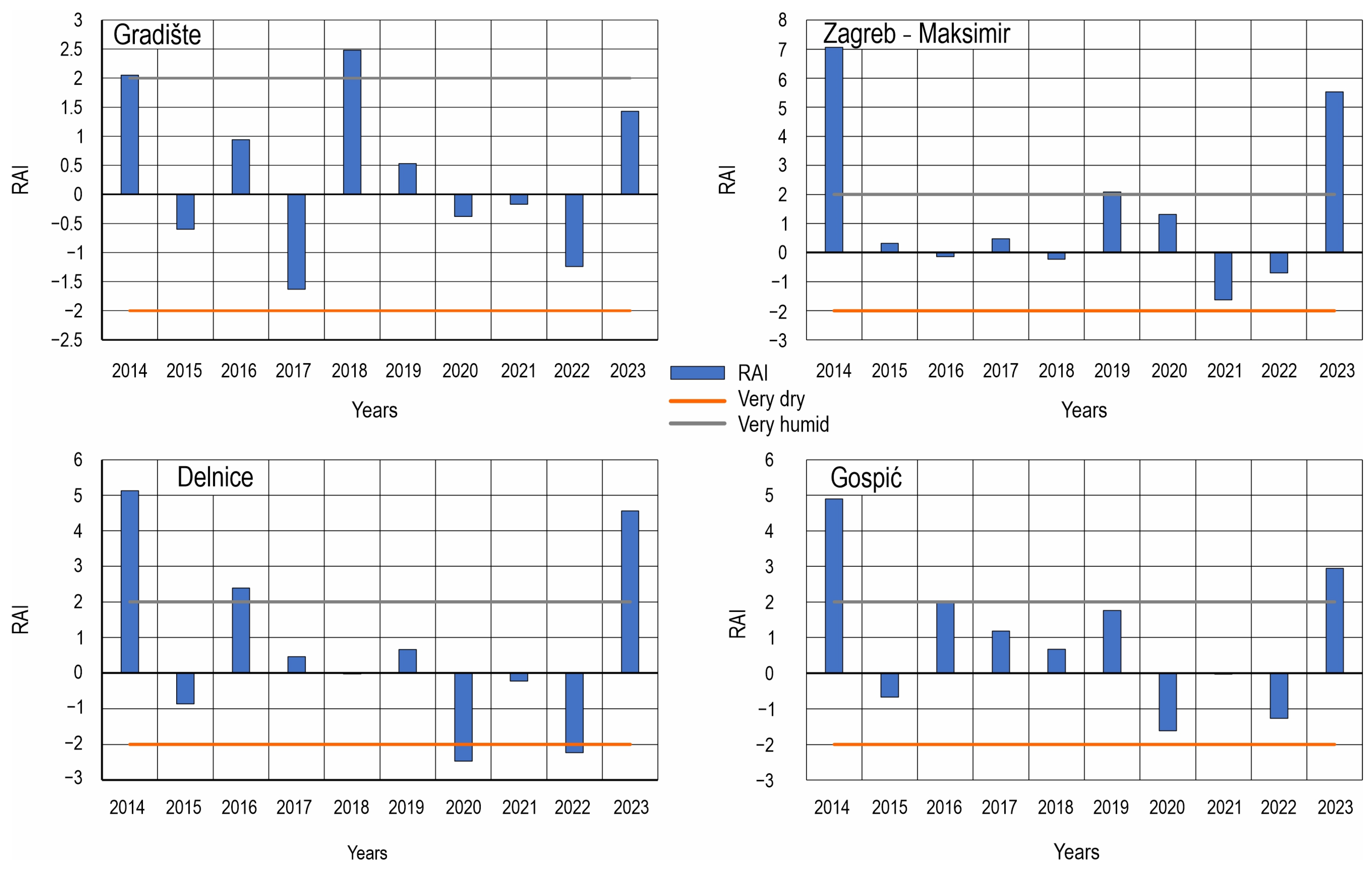
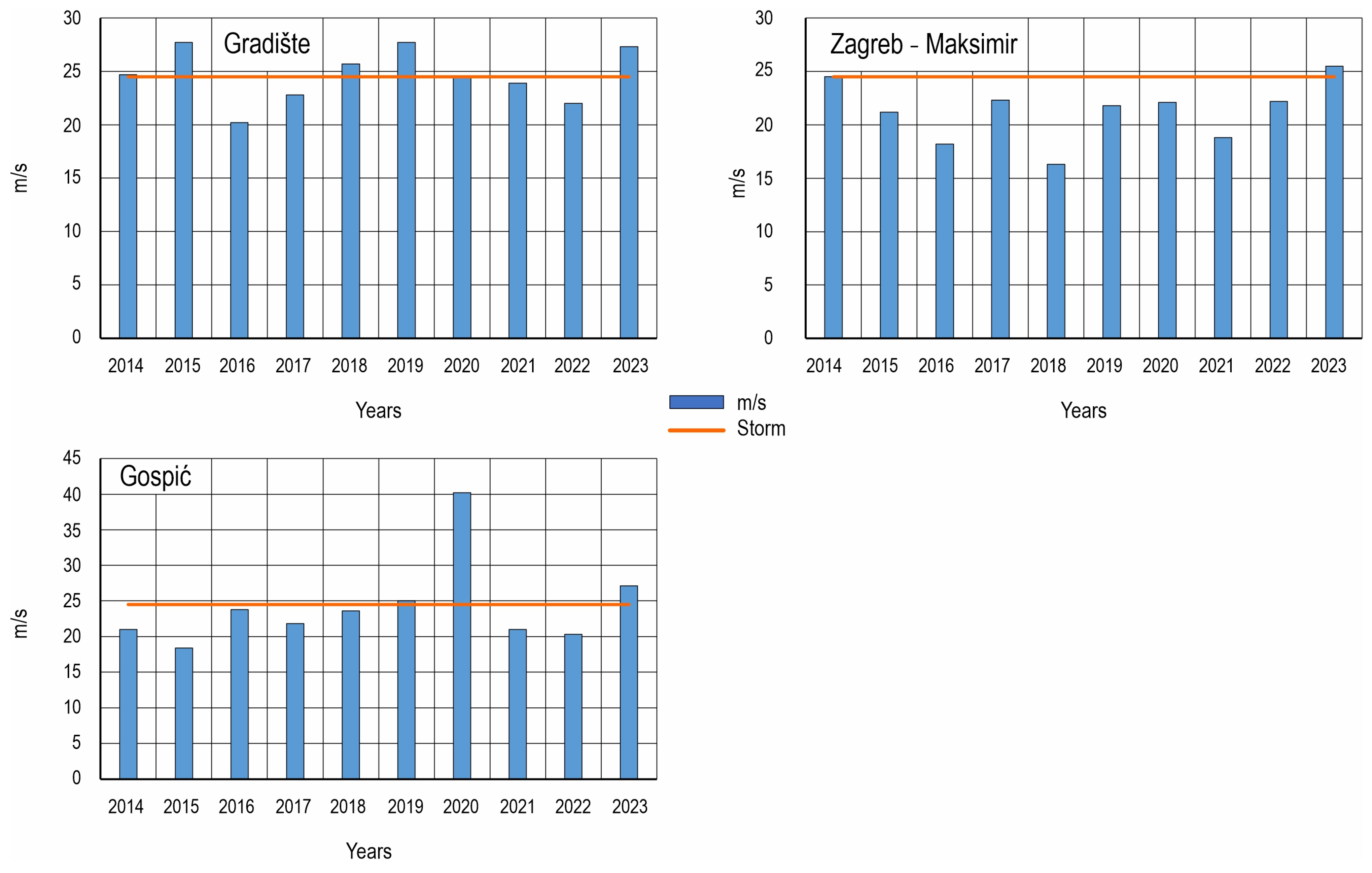
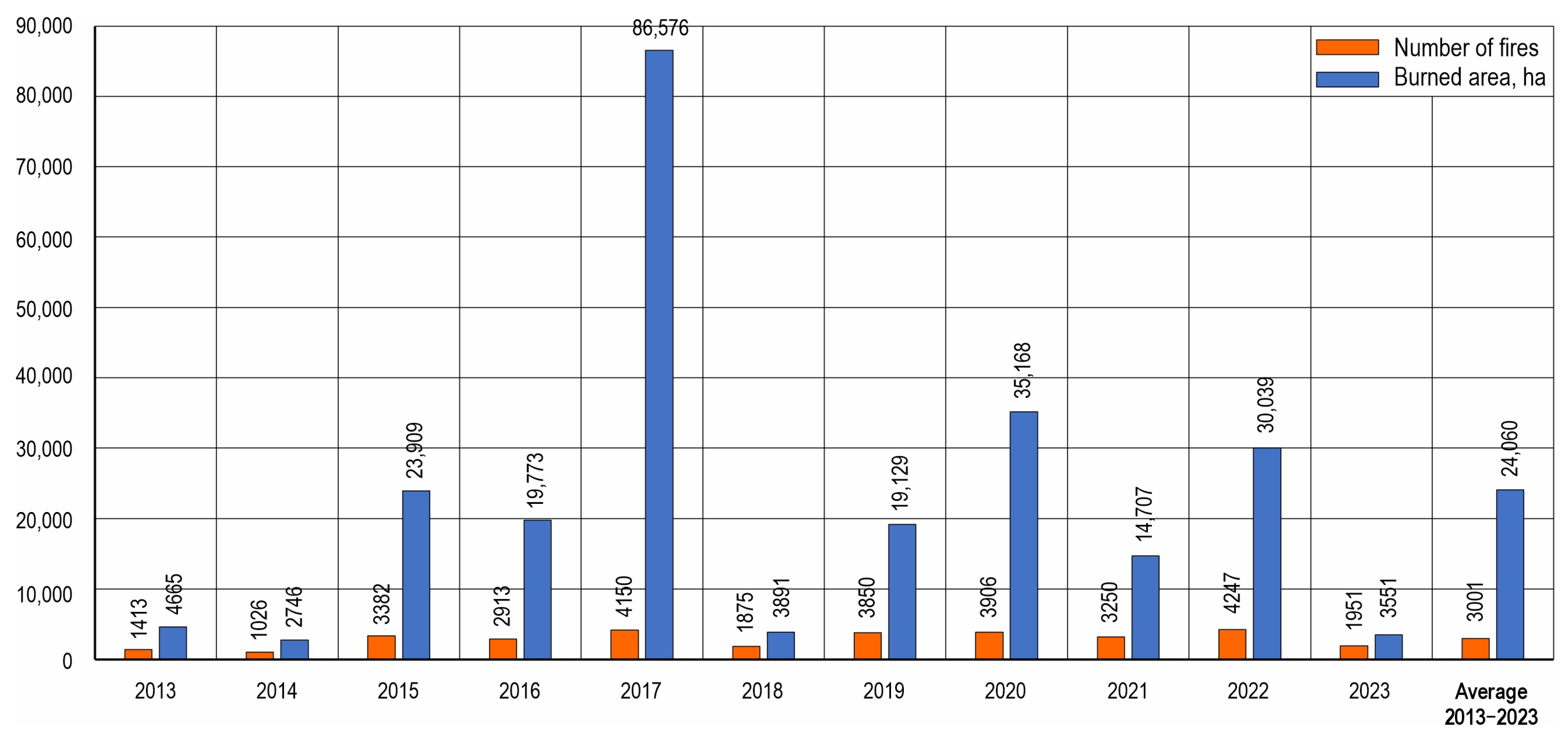


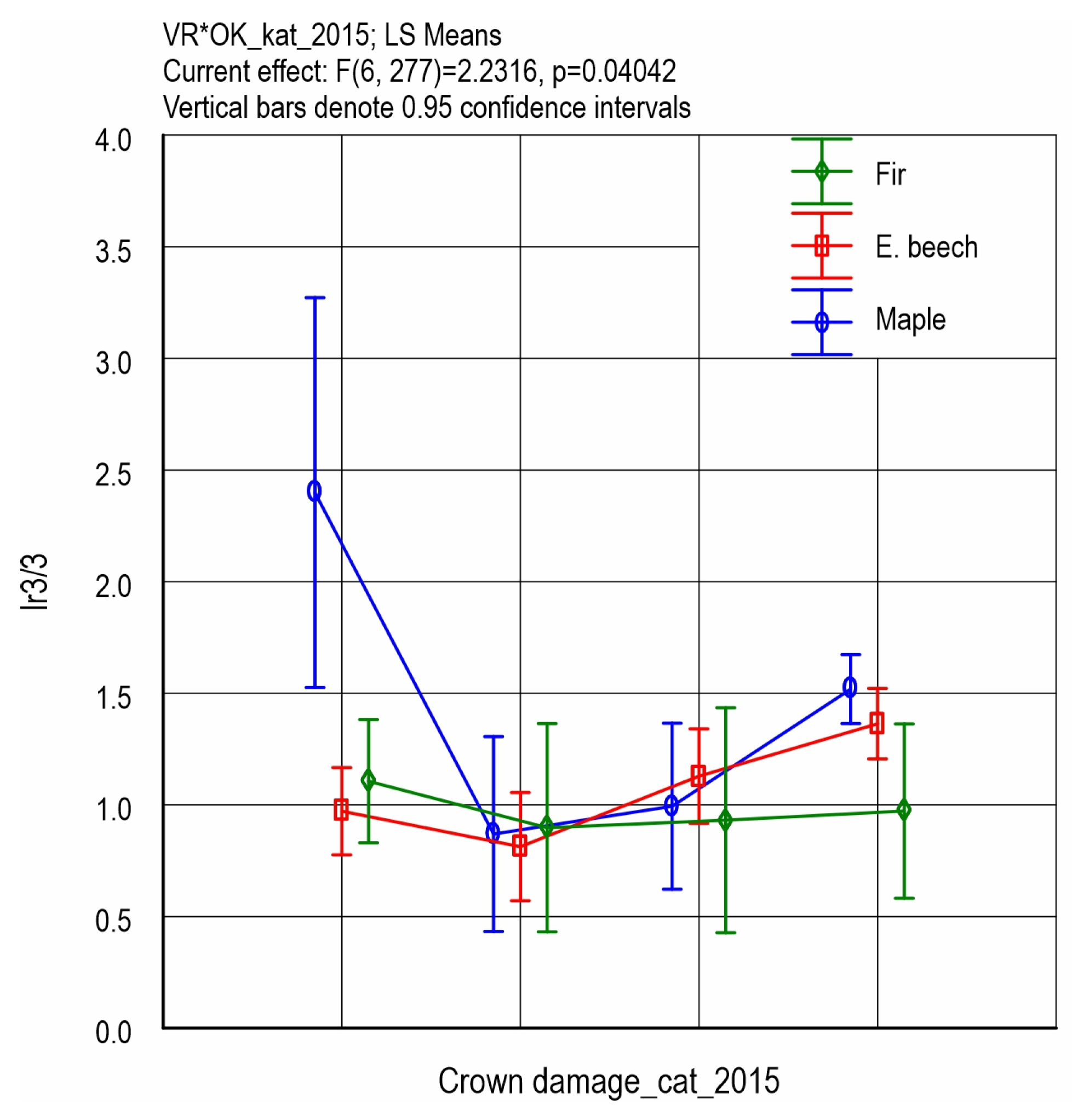

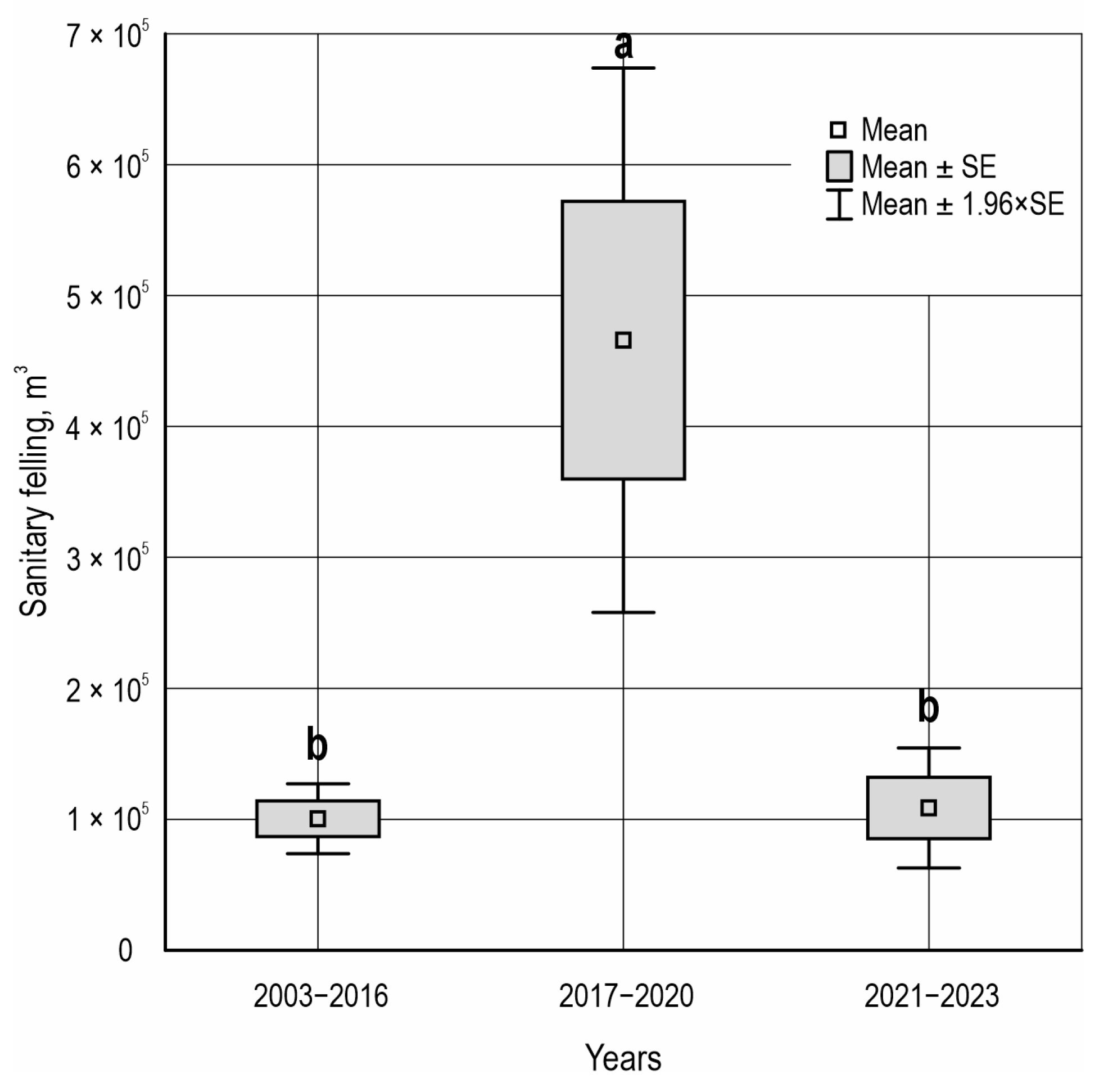
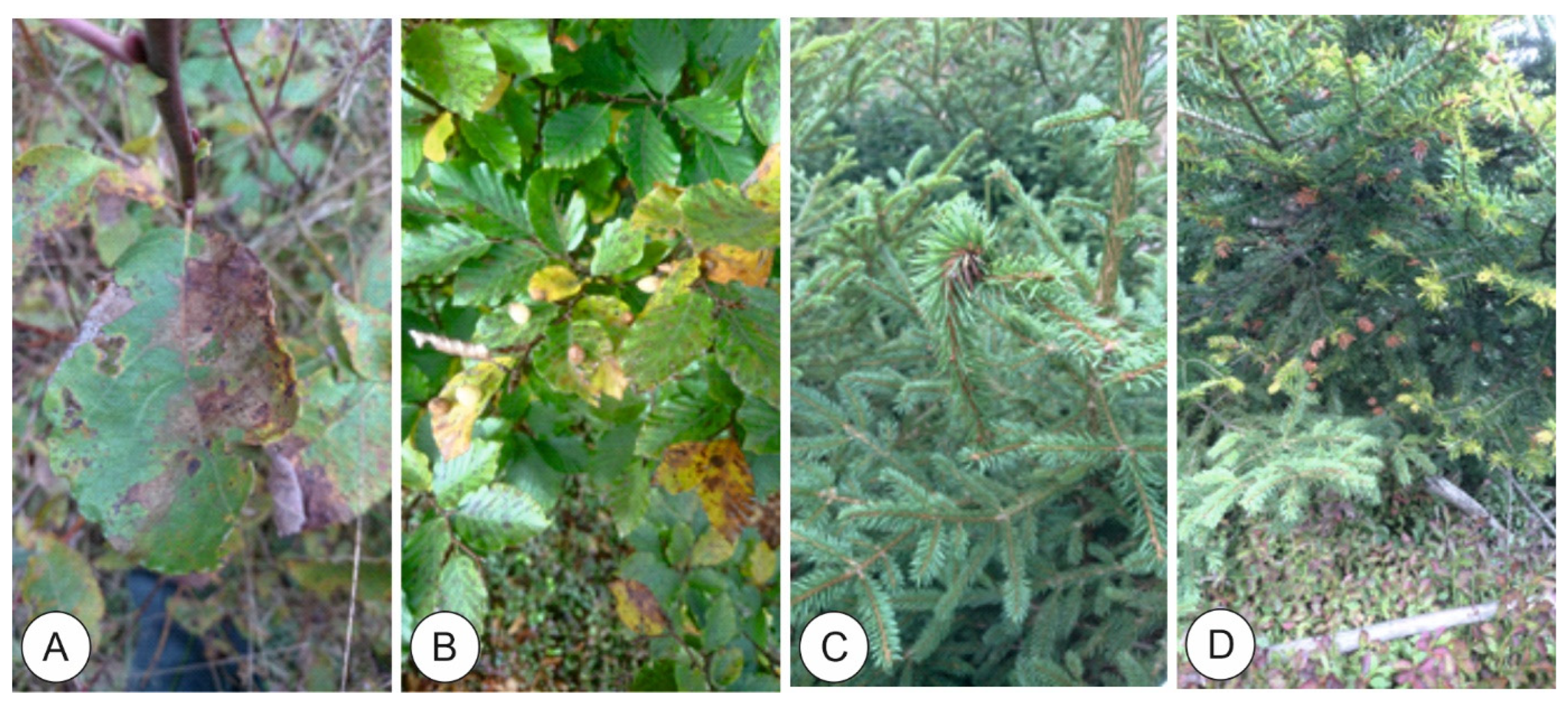

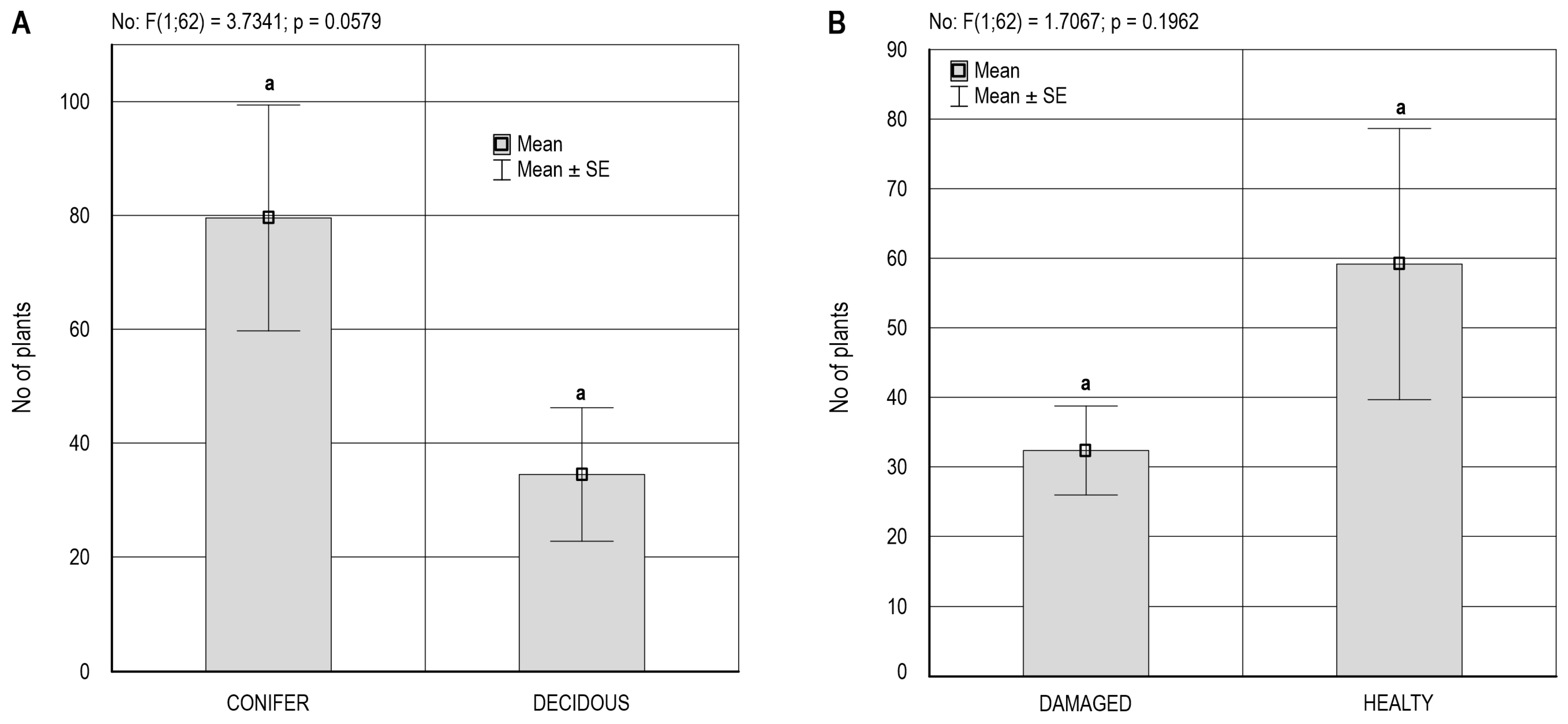
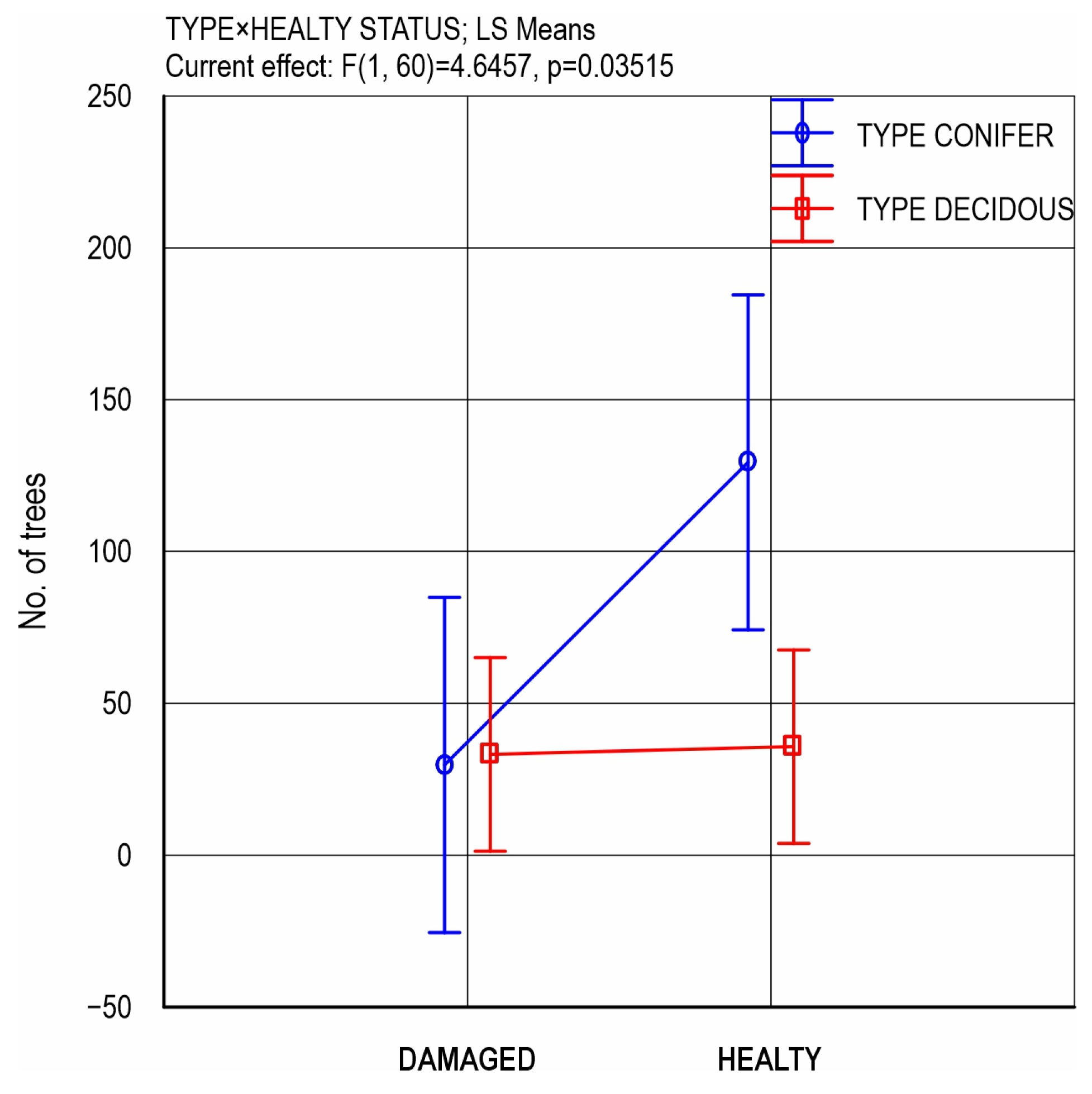

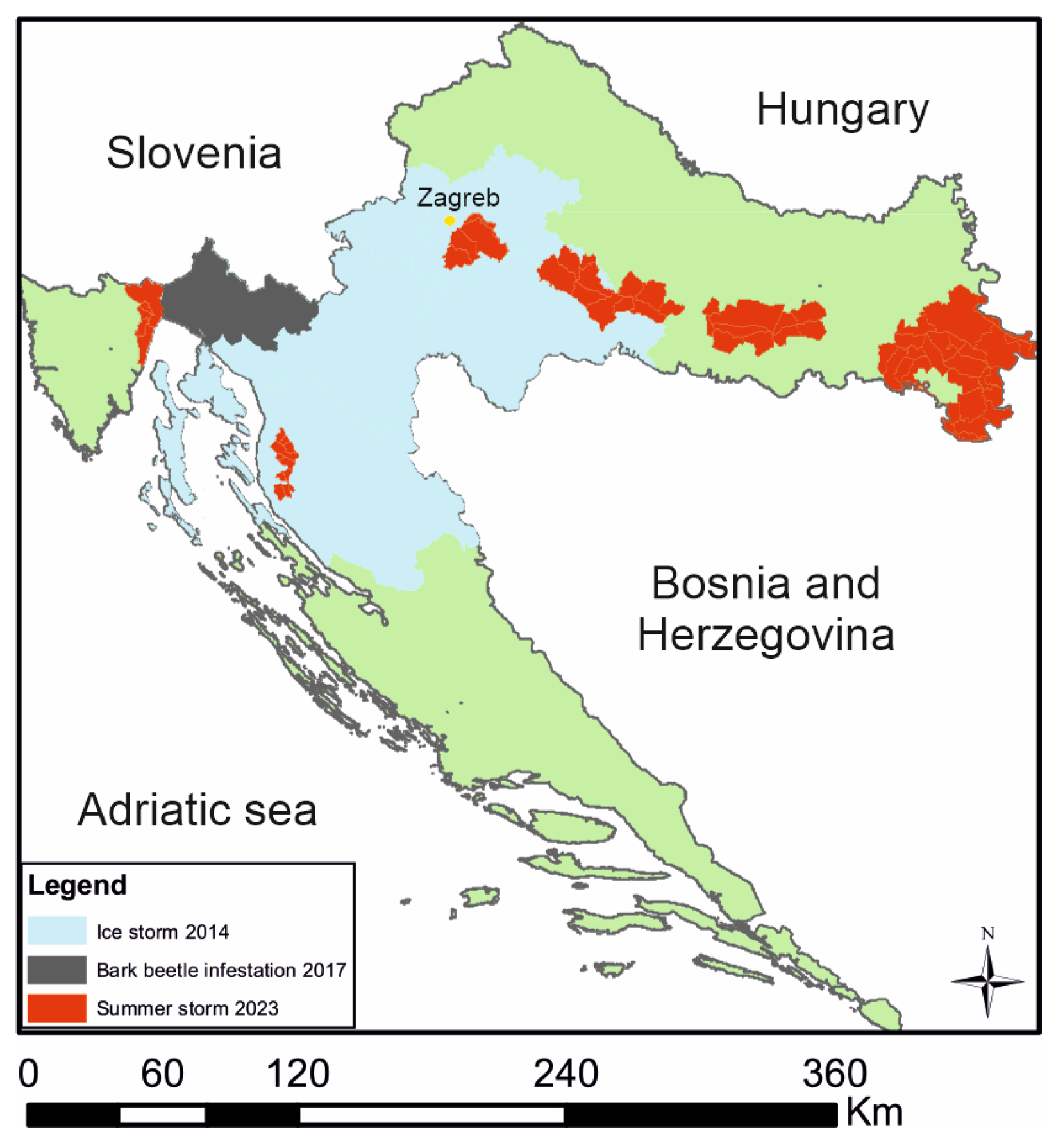
| Region | Climatic Conditions | Damage | ||
|---|---|---|---|---|
| Very Humid | Hurricane Wind | Windstorm | Windthrow | |
| Lowland | 2014; 2018; 2023 | 2014; 2015; 2018; 2019; 2023 | 2014; 2015; 2018; 2019; 2023 | 2014; 2018; 2023 |
| Dinaric | 2014; 2023 | 2020; 2023 | 2020; 2023 | 2023 |
| N | Mean | Minimum | Maximum | Std. Dev. | |
|---|---|---|---|---|---|
| Vinkovci (lowland) | 21 | 25.857 | 9.000 | 65.000 | 12.709 |
| Zagreb (lowland) | 21 | 22.000 | 16.000 | 47.000 | 6.411 |
| Bjelovar (lowland) | 21 | 13.905 | 8.000 | 31.000 | 5.576 |
| Delnice (Dinaric) | 21 | 28.476 | 7.000 | 82.000 | 20.949 |
| Region | Coefficient r/p Value | |
|---|---|---|
| Max. Wind Speed | RAI | |
| Sanitry fellings—lowland | 0.49 */0.022 | 0.55 */0.009 |
| Sanitry fellings—Dinaric | 0.27/0.22 | 0.06/0.78 |
| Open space fires in the Mediterranean karst area in Croatia | 2023 | |||||||||||
| Observed period | 2018 | 2019 | 2020 | 2021 | 2022 | |||||||
| No. of fires | Burned area (ha) | No. of fires | Burned area (ha) | No. of fires | Burned area (ha) | No. of fires | Burned area (ha) | No. of fires | Burned area (ha) | No. of fires | Burned area (ha) | |
| 1 January–31 December | 1875 | 3891 | 3850 | 19,129 | 3906 | 35,168 | 3250 | 14,707 | 4247 | 30,039 | 1951 | 3551 |
| 1 June–31 October | 1330 | 3160 | 1090 | 2643 | 1063 | 1695 | 1577 | 8444 | 1607 | 11,628 | 928 | 2690 |
| Observed period | Five-year average 2018–2022 | 2023 | ||||||||||
| No. of fires | Burned area (ha) | Average fire duration | BAI (ha/fire) | BAI (ha/fire) | ||||||||
| 1 January–31 December | 3426 | 20,587 | 2 h 40 min | 6.01 | 1.82 | |||||||
| 1 June–31 October | 1333 | 5514 | 2 h 58 min | 4.14 | 2.90 | |||||||
| Observed period | 2023/Five-year average 2018–2022 | |||||||||||
| Ratio of the No. of fires | Ratio of burned area | Ratio of the burned area index (BAI) | ||||||||||
| 1 January–31 December | −43.05% | −82.71% | −69.71% | |||||||||
| 1 June–31 October | −30.40% | −51.22% | −29.90% | |||||||||
| 2015 Year of Measurement | Tree Felling | Share | Ingrowth | Share | 2020 Year of Measurement | |
|---|---|---|---|---|---|---|
| Tree Species | No. | % | No. | % | No. | |
| Beech | 826 | 146 | 17.7 | 74 | 9.0 | 754 |
| Silver fir | 268 | 56 | 20.9 | 15 | 5.6 | 227 |
| Maple | 169 | 40 | 23.7 | 14 | 8.3 | 143 |
| E. spruce | 126 | 49 | 38.9 | 4 | 3.2 | 81 |
| TOTAL | 1389 | 291 | 21.0 | 107 | 7.7 | 1205 |
| Broadleaf (beech, maple) | |||||||
| plots | dA | hA | N | B.A. | V | OS_V | |
| n | cm | m | ha−1 | m2ha−1 | m3ha−1 | % | |
| Ice storm area 2015 | 20.00 | 21.60 | 15.90 | 436.90 | 19.10 | 209.30 | 46.60 |
| Ice storm area 2020 | 20.00 | 24.80 | 19.10 | 354.90 | 17.10 | 193.60 | 46.70 |
| Change | 3.20 | 3.20 | −82.00 | −2.00 | −15.70 | 0.10 | |
| Conifers (silver fir, European spruce) | |||||||
| Ice storm area 2015 | 20.00 | 34.40 | 21.29 | 129.50 | 16.80 | 239.90 | 53.40 |
| Ice storm area 2020 | 20.00 | 40.10 | 25.60 | 124.50 | 15.70 | 221.40 | 53.30 |
| Change | 5.70 | 4.31 | −5.00 | −1.10 | −18.50 | −0.10 | |
| All species | |||||||
| Ice storm area 2015 | 20.00 | 25.30 | 17.40 | 566.50 | 35.90 | 449.20 | |
| Ice storm area 2020 | 20.00 | 29.50 | 19.10 | 479.50 | 32.80 | 415.00 | |
| Change | 4.20 | 1.70 | −87.00 | −3.10 | −34.20 | ||
| Effect | ir3/3 | ir3/3 | ir3/3 | ir3/3 | |
|---|---|---|---|---|---|
| df a | SS b | MS c | F | p | |
| Intercept | 1 | 150.040 | 150.040 | 381.404 | 0.000 *** |
| VR | 2 | 3.265 | 1.633 | 4.150 | 0.017 * |
| OK_kat_2015 | 3 | 6.062 | 2.021 | 5.137 | 0.002 * |
| VR × OKkat_2015 | 6 | 5.267 | 0.878 | 2.232 | 0.040 * |
| Error | 277 | 108.968 | 0.393 | ||
| Total | 288 | 129.219 |
| Plots | BS | KSS | KV | Vdes. | Vsde. | pdes. | psde. | |
|---|---|---|---|---|---|---|---|---|
| Number | m3ha−1 | m3ha−1 | % | % | ||||
| species | Broadleaf (beech, maple) | |||||||
| Ice storm area 2015 | 20 | 3.0 | 0.49 | 0.81 | 70.9 | 49.9 | 33.8 | 23.8 |
| Ice storm area 2020 | 20 | 3.0 | 0.33 | 0.86 | 38.7 | 71.8 | 20.0 | 37.1 |
| Change | 0.0 | −0.16 | 0.05 | −32.2 | 21.9 | −13.8 | 13.3 | |
| species | Conifers (silver fir, European spruce) | |||||||
| Ice storm area 2015 | 20 | 2.5 | 0.40 | 0.66 | 23.2 | 18.9 | 9.7 | 7.9 |
| Ice storm area 2020 | 20 | 2.5 | 0.24 | 0.61 | 18.3 | 66.5 | 8.3 | 30.0 |
| Change | 0.0 | −0.16 | −0.05 | −4.9 | 47.6 | −1.4 | 22.1 | |
| species | All species | |||||||
| Ice storm area 2015 | 20 | 3.0 | 0.46 | 0.76 | 94.0 | 68.8 | 20.9 | 15.3 |
| Ice storm area 2020 | 20 | 3.0 | 0.41 | 0.69 | 57.0 | 138.4 | 13.7 | 33.3 |
| Change | 0.0 | −0.05 | −0.07 | −37.0 | 69.6 | −7.2 | 18.0 | |
| Univariate Tests of Significance | ||||
| Effect | df a | MS b | F | p |
| TYPE | 1 | 24,390.1 | 4.007 | 0.049 * |
| HEALTY STATUS | 1 | 31,314.1 | 5.144 | 0.026 * |
| TYPE × HEALTY STATUS | 1 | 28,275.5 | 4.645 | 0.035 * |
| Error | 60 | 6086.4 | ||
Disclaimer/Publisher’s Note: The statements, opinions and data contained in all publications are solely those of the individual author(s) and contributor(s) and not of MDPI and/or the editor(s). MDPI and/or the editor(s) disclaim responsibility for any injury to people or property resulting from any ideas, methods, instructions or products referred to in the content. |
© 2025 by the authors. Licensee MDPI, Basel, Switzerland. This article is an open access article distributed under the terms and conditions of the Creative Commons Attribution (CC BY) license (https://creativecommons.org/licenses/by/4.0/).
Share and Cite
Đuka, A.; Franjević, M.; Tomljanović, K.; Popović, M.; Ugarković, D.; Teslak, K.; Barčić, D.; Žagar, K.; Palatinuš, K.; Papa, I. A Decade of Sanitary Fellings Followed by Climate Extremes in Croatian Managed Forests. Land 2025, 14, 766. https://doi.org/10.3390/land14040766
Đuka A, Franjević M, Tomljanović K, Popović M, Ugarković D, Teslak K, Barčić D, Žagar K, Palatinuš K, Papa I. A Decade of Sanitary Fellings Followed by Climate Extremes in Croatian Managed Forests. Land. 2025; 14(4):766. https://doi.org/10.3390/land14040766
Chicago/Turabian StyleĐuka, Andreja, Milivoj Franjević, Kristijan Tomljanović, Maja Popović, Damir Ugarković, Krunoslav Teslak, Damir Barčić, Krešimir Žagar, Katarina Palatinuš, and Ivica Papa. 2025. "A Decade of Sanitary Fellings Followed by Climate Extremes in Croatian Managed Forests" Land 14, no. 4: 766. https://doi.org/10.3390/land14040766
APA StyleĐuka, A., Franjević, M., Tomljanović, K., Popović, M., Ugarković, D., Teslak, K., Barčić, D., Žagar, K., Palatinuš, K., & Papa, I. (2025). A Decade of Sanitary Fellings Followed by Climate Extremes in Croatian Managed Forests. Land, 14(4), 766. https://doi.org/10.3390/land14040766








